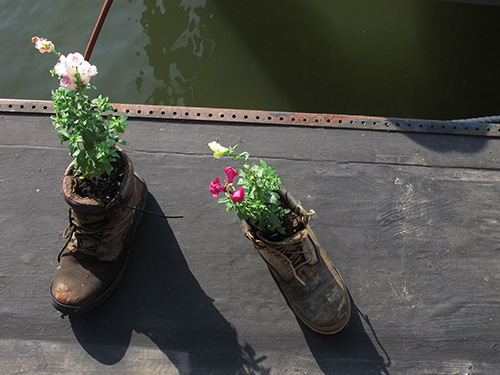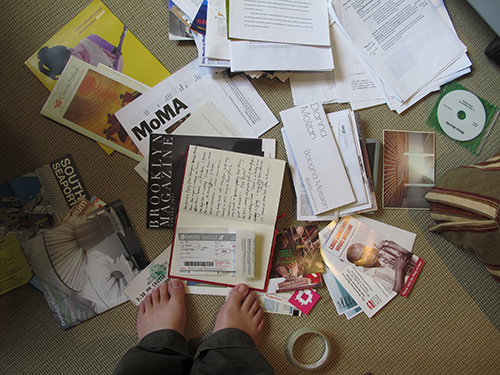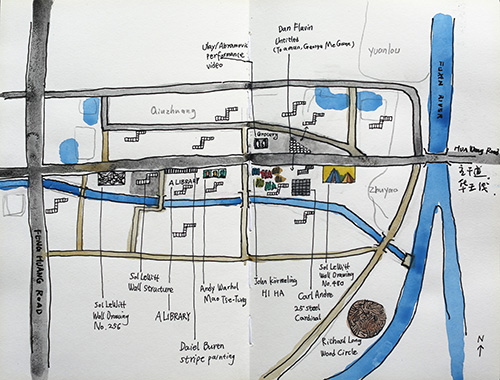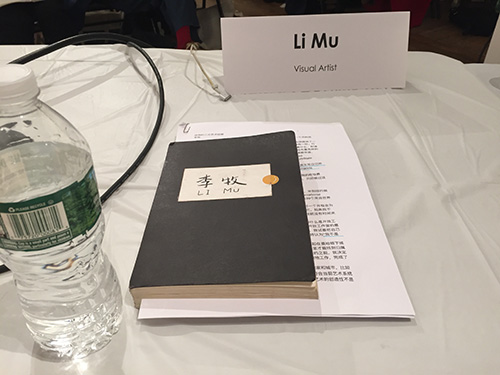|
| 谈我的三次艺术驻留Talk about my residency projects | Date :2018-10-19 | From :iamlimu.org |
| ------------------------------------------------------------------------------------------------------------------ |
![]()

1. 2011年,经上海独立策展人比利安娜的推荐,我到纽约 APEXART 做一个月的艺术家驻留。在这之前,我以职业艺术家的身份在上海工作了四年。
这是我第一次到美国。APEX ART 的驻留理念和方法有些特别,他们为我提供了一间联合广场(UNION SQUARE)边上的公寓,然后是一份行程表,每周一份。行程表很详细地引导我每日的行动,几点几分乘什么车到达什么提点、看什么、和谁见面。我按照行程表每日都穿行在纽约的大街小巷。行程表的内容包括布鲁克林的墓地Greenwood Cemetery、哈德孙河边长长的公园、斯坦顿岛上的佛教寺庙,Louis Armstrong’s house museum, Red Hook 的船上博物馆 Waterfront Museum,Roosevelt Island’s Smallpox Hospital,Coney Island,New
YorkState Criminal Court Case Hearing, Event of Experimental Cuisine…….。
当然,还有一系列的音乐、戏剧演出、展览以及会面。我每天都要用英文写日记并且上传到APEXART的博客上。驻留结束的时候,我和纽约的艺术家Amanda Browder 做了一场公开的对话。

这次驻留,Apex Art负责我的机票、住宿和所有参观的门票,不负责我的吃饭费用。在行程表里,也有品尝当地食物的安排,很遗憾,我没有多少钱,只好略过这样的节目。

2,2012年,我获得了亚洲文化协会(ACC)的奖助金,35000美金,来到纽约做5个月的驻留。我的驻留机构是位于布鲁克林布什维克的 ISCP(International Studio & Curatorial
Program ),我有一间很大的工作室,同时期有39个来自世界各地的艺术家在这里驻留创作。
我从来没有过自己的工作室,我一直都是在家里工作。这一次,面对一个月租金为2000美金的工作室,一个空荡荡的工作室,我不知道我该如何使用它。如果我不来工作室上班,我就浪费了这个空间;如果我每日来工作室上班,我就没有时间来探索这个丰富的城市。
就这样犹豫着、徘徊者,就到了5月份开放工作室的日子。我不理解什么是开放工作室,我还是把它当做一个展厅来展示我的作品。后来我明白了,开放工作室的意义是要呈现出自己的工作状态,作品是否完成并不重要。那段日子,我试着把自己变成一个职业的、有工作室的艺术家,我不习惯。最后,我还是坚持认为“我不是一个工作室艺术家”。
在我的驻留快要结束的时候,我做了一件作品。我常常和朋友们一起在曼哈顿下城的唐人街吃饭、购物,似乎那里可以缓解我的思乡之情,或者在那里才能找到归属感。相比纽约的其他社区,唐人街要脏乱的多。最后,在我离开纽约之前,我决定用一把扫帚把唐人街清扫一遍。我用了一个星期的时间,早出晚归地工作,完成了36条街道的清扫。这个作品的名字就叫唐人街。
在 ISCP 驻留期间,我发现那些我喜欢的艺术家往往来自非中心国家和城市,比如墨西哥、土耳其。我发现大多数的艺术家都是在制造产品,制造符合当前艺术系统的艺术产品,这样的作品很容易被流通和消费,却没有创造性。艺术的创造性不是博人眼球的新鲜感,而是一种精神,是一种活着的态度。

3, 仇庄位于中国的北京和上海之间,我1974年出生在这里。之所以做仇庄项目,是因为我和我的家人因为我离开多年而产生的隔阂和距离。我们难以沟通,我的亲人都不理解我作为艺术家的工作。我常常感到恐惧,我恐惧这种彼此不理解带来的的心理伤害。
我决定回到我的村庄工作,我要和我的家人一起工作,这可以让我进一步了解他们以及这个村庄,也让他们看到我的艺术。
我和荷兰 VAN ABBE 美术馆(Van Abbemuseum)合作,从他们的馆藏里选择了8位艺术家的10件作品,用复制的方式展示在我的村庄里。我从建立一个图书馆开始工作,用了一年多的时间复制了Sol LeWitt, Andy Warhol, Dan Flavin, Ulay/Abramovic,John Kormeling,
Richard Long, Carl Andre 和 Deniel Buren的作品。这些作品大多展示在村子的主干道旁边,有的在村民的家里,商店里,或者村外的田野里。
我这次在村子里工作了13个月,得以和很多人建立了新的关系。他们先后参与进我的项目,包括我的父母、我的小学老师、村里的老画师、我父亲的朋友、商店老板、我的中学同学等。
做这个项目就像打开了一扇窗户,村民从窗户看到了外面的世界,外面的人也从这个窗户看到这个村庄。
我称这个项目为驻留,它不是通常意义上的艺术家到一个陌生的地方去创作,而是回到最熟悉的地方去创作。最熟悉的地方,也是最陌生的地方。
4,总结一下我的三次驻留项目,他们都很不一样,对我都有不同的意义。在 APEX ART 驻留,虽然没有工作室,却像探险一般为我打开了从多方位认识纽约的渠道。通常,我们总是以游客或者艺术家的角度来观看纽约的。它给了我拥抱世界的信心,他让我坚信,无论在哪里,我都是这个世界的一部分。这次驻留的影响力是持久的,却也是难以测量和界定的。
在 ISCP 的驻留,时间长,有工作室,让我有更多时间专注于对艺术本身的思考上。让我在原来的工作节奏上暂时停了下来,并且转向一个更广阔的空间来创作。
在仇庄的驻留,时间更长,艺术以项目的形式呈现。它使我的艺术建立在一个村庄里,对自身的影响很大,也给村庄带来很大的影响。
因此,1,我个人比较倾向于长时间的驻留项目,超过6个月或者有多次在同一地点驻留。这样能让艺术家有足够的时间来研究和思考,有充足的时间来消化当地的文化,并用在地的实践落实自己的思考。2,在驻留期间,艺术家必须要走出工作室,和驻留地以及社群用艺术建立关系。3,需要有充足的生活和创作经费。这非常重要,因为我看到很多驻留项目都只提供工作室,生活却要艺术家自己出钱。大多数有独立思考能力的艺术家都很贫穷,这样的艺术家都以探索和突破艺术的边界为工作,而不愿意把自己的作品商业化。4,驻留申请时填写的驻留创作计划不是必须的。因为这个计划是艺术家凭借经验和想象做出来的,这会阻碍艺术家到了驻留地后的无限可能。
Talk about my residency projects
Li Mu
1. Apexart
In 2011, I went to Apexart for a month residence in New York.I was recommended by
Biljana Ciric,an independence curator based in Shanghai.That time,I had worked 4
years as a freelance artist in Shanghai.
It’s my first time to America.The residency’s style was different and special in Apexart.
They arranged an apartment beside Union Square and gave me a schedule every day.I
would followed the schedule to visit the city,include what time I reached what place
,meeting with whom,and witch bus or train I took.So I walked in New York follow the
schedule every day.It’s included Greenwood Cemetery in Brooklyn,a long park beside
Hudson river,A buddha temple in Staten Island,Louis Armstrong’s house museum in
Queens,the Waterfront Museum in Red Hook,Roosevelt Island’s Smallpox
Hospital,Coney Island,New York State Criminal Court Case Hearing,Event of
Experimental Cuisine.Of cause,There were a series concert,performance,exhibition and
meeting.I was asked write diaries and upload on their blog.In the end,I had a public talk
with Amanda Browder,an women artist based in New York.
This residency in Apexart,They pay my flight,apartment and all tickets,but not include
my foods.There were some arranges for local foods in the schedule,but I had to skip it
because I no enough money.
2,ACC’s fellowship
In 2012,I get ACC’s fellowship .I had a 5months residence in New York.I have an
apartment and a studio. My residence institute was ISCP in Brooklyn.My studio was
very big.Same time there were 39 artists they came from different country.
I always worked in my home and no studio.This time,I faced a 2000 use per month
studio,a empty room, I did not know how to use it.If I didn’t worked in the studio,I
would waste the studio;If I came to the studio every day,I would no time for research
the city.
Time was fast,It’s time to open studio in May.I din not understand what is open
studio,so I put my studio as exhibition space to present my works.Late I understood
that I can present my working status,even works not finished.Those days,I try became
a studio artist,but I couldn’t did it.At last,I still think I am not a studio artist.
Near the end of my residency,I made a performance works. I often meet my friends in
China Town in Manhattan ,we eat and shopping in China Town.I have s special feeling
to China town.But it’s dirty than other district in New York. Finally ,I decided to sweep
China Town use a broom.I worked in China Town one week,from morning to night,I
finished about 36 streets. This works named China Town.
I found that the artists I liked often came from non-central countries and cities, such
as Mexico and Turkey. I found most artists were make art productions for art system, It
is easy to be circulated and consumed,but it’s no creation. Artist’s creation not to
made beautiful or wonder things,it’s an attitude about living.
3,Qiuzhaung Project
I was born in Qiuzhang in 1974, it is a village between Beijing and Shanghai. About
Qiuzhaung Project,because the gap and distance between me and my family.My
relations could not understood my way as an artist.I always scared these gap hurt us
each other.This is why I came back to work in my village,I would work together with
them for we can understand each other.
I collabrated with Van Abbemuseum, the museum based in Eindhoven,the
Netherlands.I selected 10 art pieces and copied them in my village.My work from
founded a library in the village,than I copied Sol LeWitt, Andy Warhol,Dan
Flavin,Ulay/Abramovic,John Kormeling,Richard Long,Carl Andre and Denial Buren’s
works.Most of them presented in the public space,some of them presented in grocery ,
people’s homes and the land.
I lived my village 13 months, I got good relationships with my parents,my primary
school teacher,the old painter,the boss of the grocery,my mid school classmates.
This project like a window,villagers can see the outside world and the outside word can
see the village from the project.
I called the project is a residency because it about an artist came back to work in a
familiar place.The most familiar place,the most strange place.
4,A conclusion
To sum up my three residency projects, they are all different and have different
meanings for me. Residence in Apexart, although there is no studio, it has opened up a
channel for me to understand New York City. It gave me the confidence to embrace the
world, and he made me believe that I am part of this world . The influence of this
residency is long-lasting, but it is also difficult to measure and define.
In the ISCP's residency, the length of time, and the studio, let me have more time to
focus on the thinking of the art itself. It let me stop a moment and turn to a wide space
to work.
Residence in Qiuzhuang, the time was longer and it as a long time project.It makes my
art worked in a village,it influence me and influence the village.
I personally prefer a long-term residency project, more than 6 months or multiple times
in the same location. This will allow the artist have enough time to study and think,
have plenty of time to research the local culture, and use his practice to implement his
own thinking.
Artist should walk out the studio and made a relationship with the location .
Artist need enough money for living and work.It’s very important because most good
artist are poor, they put their time and energy on working,not on business.
Proposal is unnecessary .It’s a limit to artist when he reach a new place.

Creative China Festival 2018: International Artist Residencies Panel & Discussion
Friday, October 12, 2018 | 1:00 – 8:00 PM
La MaMa Galleria, 47 Great Jones Street, New York City, 10012
The Asian Cultural Council, the Beijing Contemporary Art Foundation, and La MaMa
E.T.C. are committed to providing support and resources for artists and arts
professionals. We believe that international cultural exchange is a powerful tool
bringing benefit both to the individual artist, the communities in the exchange country,
and their communities at home. Furthermore, that this cultural exchange is essential to
fostering understanding and respect in the world.
Since China and the U.S. established diplomatic relations, the exchange of artists has
been a critical vehicle for bringing understanding and appreciation of each other’s
cultures. The need for understanding and respect, based in relationships forged over
time, is an imperative for cooperation and lasting amity. Artist residency programs
committed to the exchange of artists between China and the U.S. present
opportunities for building relationships.
To explore the possibilities of artist residency programs, we are gathering arts
professionals who design and run residencies alongside artists who have participated
in such programs for three panel sessions and discussion. The purpose of this
gathering is to promote dialogue and learning to create effective opportunities for the
future.
1:00 – 1:25 PM | Introductory Remarks
Mia Yoo, Artistic Director, La MaMa E.T.C.
Cui Qiao, President, Beijing Contemporary Art Foundation Miho Walsh, Executive
Director, Asian Cultural Council
Keynote Speech
Ping Chong, Artistic Director, Ping Chong + Company
1:30 – 2:40 PM | Panel 1: Artist Residencies and Community Engagement Moderator:
Jamie Bennett, ArtPlace America
Panelists:
Mia Yoo, Artistic Director, La MaMa E.T.C.
Jay Brown, Founder/Director, Lijiang Studio
Fito Segrera, Head of Research and Creation, Chronus Art Center (CAC)
Discussion:
How do differing residency models (production-driven, process-driven, urban, rural,
international, hyper-
local, interdisciplinary) approach community engagement and education?
What kind of programming/services does the residency provide and how do they
serve the goals of
community engagement and education?
2:45 – 3:55 PM | Panel 2: The Experience of the Residency Moderator:
Jane DeBevoise, Chair of the Board of Directors, Asia Art Archive
Panelists:
Jennifer Wen Ma, Visual artist
Li Mu, Visual artist
Ursula Eagly, Dancer/choreographer
Discussion:
What enabled you to connect with the local community (both the community of
artmakers and local residents)?
What kind of support did you find most useful in pursuing your goals for the
residency?
3:55 – 4:10 PM | Session Break
4:10 – 5:25 PM | Panel 3: After the Residency
Moderator:
Cecily Cook, Director of Programs, Asian Cultural Council
Panelists:
David Diamond, La MaMa Umbria Coordinator, La MaMa E.T.C.
Susan Hapgood, Executive Director, International Studio & Curatorial Program René
Lorenceau, CEO, Swatch Art Peace Hotel Artist Residency
Discussion:
How do residencies engage alumni?
What is the role of technology in the post-residency relationship?
How, besides commercial success, do we measure the success of residency
participants immediately after
their program and years later?
• How do residencies track their alumni?
5:25 – 6:00 PM | Closing Remarks/Discussion
Karen Wong, Deputy Director, New Museum
6:00 – 8:00 PM | Dinner & Reception at La MaMa Galleria
|
------------------------------------------------------------------------------------------------------------------
© iamlimu.org 2011 |
|

